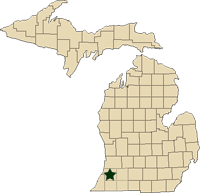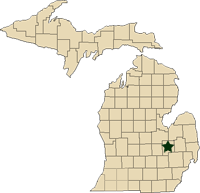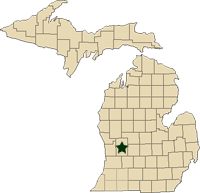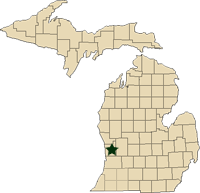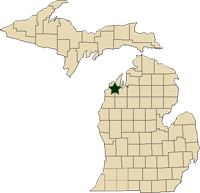Regional reports on Michigan fruit – August 23, 2011
MSU Extension educators’ pest and fruit updates for Michigan.
This week’s regional reports:
- Southwest Michigan - Mark Longstroth, Bill Shane, Diane Brown
- Southeast Michigan - Bob Tritten
- Grand Rapids Area Tree Fruit - Amy Irish Brown and Phil Schwallier
- Grand Rapids Area Small Fruit – Carlos García-Salazar
- Northwest Michigan - Nikki Rothwell, Duke Elsner, Erin Lizotte
Southwest Michigan – Mark Longstroth, Bill Shane, and Diane Brown, Michigan State University Extension
|
Last week’s weather was pleasant and dry with highs near 80 and lows in the 50s. Storms moved across the region Saturday, August 20. Rainfall was an inch or less north of I-94. Soil conditions are generally moist. This week is forecast to have highs in the 80s and lows around 60. The region is close to normal for heat accumulation (GDD). 2011 is similar to 2006, ahead of 2008 and 2009 but behind 2010 and 2007. Because of the cool, wet spring, fruit harvest appears to be about five days later than predicted for apples and 10 days later for peaches. Find the closest weather station near you at Enviro-weather.
|
Southwest Michigan Growing Degree Day Totals from March 1 - August 21 |
|||
|
Location |
GDD 42 |
GDD 45 |
GDD 50 |
|
3161 |
2764 |
2150 |
|
|
2972 |
2590 |
1995 |
|
Tree fruit
There have been no reports of brown marmorated stink bugs in the area this year. San Jose scales have been showing up on various fruit types.
In peaches, Red Haven harvest is ending. Other varieties being harvested include Blazingstar, Coralstar, Bellaire and Canadian Harmony, plus Flamin’ Fury varieties PF Lucky 13 harvest is peaking and PF 17 has started. Fruit size has improved as we move into these later varieties. Since peaches are harvesting late, growers should be monitoring peach fruit for the desired ripeness. Brown rot infections are a problem in some orchards. Heavy infections seen on scattered individual trees are generally due to early green fruit infections that initiated abundant spore production early in the season. In young orchards, it is worthwhile to knock brown rotted fruit off the tree to ward off gumming of scaffold limbs by infections moving into wood. Trap catch of oriental fruit moths is up in orchards we trap.
In cherries, cherry leaf spot symptoms are spotty with new waves of yellow leaves appearing in some orchards. Mature cherries can be pruned until early September.
Plum harvest continues. Stanley plum harvest should begin late this week or next. Plums should be protected from brown rot and apple maggots. White apple leafhoppers will also attack plum leaves, causing white speckling on the leaves.
Apples are almost 3 inches in diameter and beginning to size well. Paula Reds, Zestar and Early Mac harvest is underway with Gala not too far away. We are about five days later than the predicted apple harvest dates. Trap catches for oriental fruit moth and codling moth remain high at several locations we trap. Flight of the summer generation of obliquebanded leafrollers has begun and apple maggot flies are out. The treatment threshold for European red mites is seven mites per leaf. Heavy populations of green apple aphids can still be found on suckers and shoots tips.
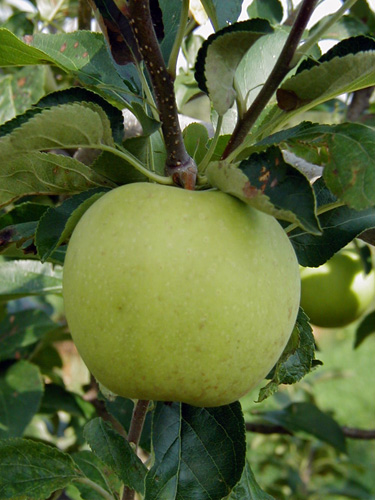
‘Golden Delicious’ apple.
In pears, Bartlett harvest is underway.
Small fruit
Japanese beetles are scarce. Spotted wing Drosophila flies have been caught in Allegan (blueberries and black raspberries), Van Buren (grapes) and Ottawa counties.
Grapes are generally at veraison and color is visible in Concord. Niagara harvest is forecast to begin on September 16 and Concord about 16 days later. The third generation grape berry moth is flying. Grape berry moth trap catches have been low, but are starting to increase as the third generation flight continues. Infested clusters in low pressure and high pressure sites were 4 percent and 32 percent, respectively. Growers should be checking their vineyards to assess grape berry moth control and making decisions for additional treatments accordingly. In the last grape newsletter (August 11, grapes.msu.edu) Steve Van Timmeren stated that grape berry moth infestation should be kept to about 6 percent in vineyard interiors.
More powdery mildew has been observed in untreated research plots, but not in treated commercial vineyards. We are beginning to see defoliation from downy mildew in commercial vineyards. Extensive periods of morning ground fog and dew continue to provide favorable conditions for downy mildew across the southwest region, so preventative treatments should be continued. Phomopsis is showing up on berries at some locations. No major damage from grape leafhoppers and potato leafhoppers has been reported. There is still time to do tissue testing for grapes, which are normally sampled at veraison.
Blueberry harvest is ending. Jerseys are being cleaned up with machines. Hand and machine harvest of Elliott is underway. Some growers report low yields of Elliot. Other growers report poor berry size and blame poor pollination in the spring. The primary insect pest is blueberry maggots. Abandoned and poorly sprayed fields are infested with blueberry maggots and this fruit is unsellable.
Spotted winged Drosophila has not been found in blueberries in Van Buren or Berrien counties. Alternaria is the most common fruit rot in ripening fruit. Harvest sprays should protect fruit from maggot and alternaria.
Strawberry fields are generally growing well and running, except where potato leafhoppers have stunted growth. Seascape and Albion are two everbearing varieties being harvested.
In brambles, blackberry and fall raspberries harvest continues. Heavy morning dews can make gray mold a problem. Spider mites may also be an issue, especially in high tunnels. Growers should take time to assess injury levels and treat accordingly.
Southeast Michigan – Bob Tritten, Michigan State University Extension
|
Weather
Most areas of southeast Michigan have had enough rain over the last three to four weeks to relieve earlier drought stress symptoms. There are a few isolated parts of our region that have not had the big rain events that slow moving thunderstorms have brought. Most growers in southeast Michigan have received around 1.5 inches of rain in the last two weeks. Hail was reported in Saturday’s (August 20) afternoon storms north of Flint and in the Ann Arbor area.
Soil moisture supplies continue to be replenished from recent rain events. Most tree and small fruits are no longer showing signs of drought stress.
Our season is still running about five days ahead of normal when I compare degree day totals. However, the beginning of harvest of some of our fruit crops, most noticeably Red Haven peaches and Paula Red apples, have been delayed a bit, indicating that horticulturally the season is a bit behind normal. I understand that this does not make sense, however, there is a great deal about the weather this season that does not make sense.
|
East Michigan Growing Degree Day Totals for March 1 to August 22 , 2011 |
|||
|
Location |
GDD42 |
GDD45 |
GDD50 |
|
3082 |
2699 |
2100 |
|
|
3020 |
2640 |
2050 |
|
|
Flint (Genesee) |
3071 |
2680 |
2085 |
|
3057 |
2674 |
2081 |
|
|
3251 |
2853 |
2231 |
|
|
2846 |
2474 |
1900 |
|
|
3111 |
2731 |
2139 |
|
Tree fruits
Apple size continues to show great progress, despite dry soils at many farms for a prolonged time earlier this summer. Most apples are around 3 inches in diameter. Growers are beginning to harvest Paula Reds over the last few days and are beginning to eyeball Gingergolds and Zestar. I am concerned that these early apple varieties aren’t ripening as they normally do. All three of the varieties are softer than typical and frankly do not have the flavor as they do most years. I don’t know what this means in terms of maturity or ripening of our main apple varieties to follow, but it may be a foreshadowing of things to come this fall. In sampling Gingergold at several farms yesterday (August 22), I would say that most farms are about three to four days away from beginning of harvest.
Apple pests are generally on the decline across the region. Apple maggot trap catches have generally been low over the last week, as have been codling moth and oriental fruit moth. I have had several calls from fruit growers saying that they have seen codling moth fruit injury. In checking these orchards, it appears that this damage was caused from the first generation larvae. Many years this fruit drops to the orchard floor prior to harvest, but this year it seems to be hanging on. Wooly apple aphid populations are under control at most farms. European red mite numbers remain high in localized hot spots in many blocks of apples. Most growers have chosen to let predators feed on the European red mites. There continues to be an excellent predator population that has been steadily building throughout the season.
While I have not seen any sooty blotch or fly speck in commercial plantings, in the past few days I am starting to see sooty blotch and fly speck in under sprayed or unsprayed apple blocks. Heavy rain events of this spring and rain events over the last several weeks are a concern to me regarding late season disease control. I have made recommendations to numerous fruit growers that one more fungicide may be very beneficial this year, not only to prevent sooty blotch and fly speck, but also to control black rot in other late season fruit diseases. I encourage growers to do a good job of evaluating this season’s apple scab control program. Many growers are commenting that they are seeing more scab this season than they have in several years. I feel that we had extreme pressure this year and the result is more scab is showing up in orchards. Look for a more complete report later in the week or next week on my observations of apple scab control for next season. In the meantime, I encourage you to keep an eye for apple scab in your apple blocks and also in landscape plantings where crabapples have lost almost all their leaves due to apple scab.
Pears continue to size fairly well with most being in the range of 2.5 to 2.75 inches in diameter. In checking several pear blocks yesterday, they appear to be at least a week or 10 days away from being ready for harvest. I encourage growers to keep a close eye on them this year. There are many pear blocks that have a good crop of fruit, which may not mature evenly. I have not seen the final swell in fruit size in pears.
Peach harvest continues with Red Haven harvest winding down and growers moving on to other varieties. Red Havens finally took on a nice swell last week and are eating very well at this time. There have been several peach plantings that have had some low level populations of oriental fruit moth infest the fruit. Some of these blocks are pheromone disruption blocks. I am not certain if the pheromone disruption is breaking down or if the pressure from oriental fruit moth is greater this year than most. Many growers are not accustomed to seeing this level of oriental fruit moth damage.
Sweet and tart cherry leaf drop has slowed where post-harvest fungicide applications have been made. I am particularly concerned about the potential of winter injury in tart cherries where leaf drop was extensive.
Plums continue to color well, with harvest expected to begin in three weeks.
Small fruits
Strawberries continue to send out new runners and to fill in the rows for newly planted strawberries. Renovated strawberries have looked much better over the last two weeks in terms of the volume of leaf growth. Weed pressure continues to be an issue at many farms across the region. I have seen many fields where herbicide applications made at renovation time do not appear as if they are holding up very well. Growers may consider an herbicide application toward the end of the month or the first week of September, around Labor Day.
Raspberry harvest continues for fall red raspberries. Demand has been very good at most farms. Several pick-your-own farms have closed for a few days to allow more berries to ripen. Japanese beetle populations are on the decline at almost all farms that I have visited, however I continue to get calls from a few fruit growers that tell me that Japanese beetle populations were higher this year than ever, and are continuing to be an issue. So some growers continue to have Japanese beetle populations high enough that an insecticide application may be required.
Blueberry harvest continues across the region, however, most farms seeing that berry size has diminished to a point where they will most likely only be open for another week to 10 days. Blueberry maggot trap catches have been low over the last week. Japanese beetles continue to be a problem at a few farms.
Grapes continue to color well for Concord types. French hybrids are at berry touch and also are beginning to color and size. Grape berry moth flight continues for adults. Most growers have applied their final grape berry moth sprays in the last week or so. Powdery and downy mildew symptoms are starting to be seen.
Grand Rapids Area Tree Fruit– Amy Irish Brown and Phil Schwallier, Michigan State University Extension
|
Weather and crop summary
The past two weeks have brought temperatures closer to seasonal normals. Rainfall has been above normal on the Ridge and in Belding, but normal to below normal in areas more to the north. Stormy weather brought hail on August 13 to some areas of the Ridge.
Degree accumulations indicate six to eight days ahead of normal averages, but the later season tree fruits (peaches and apples) seem to be behind the predicted harvest dates. It is thought that the predicted apple harvest dates are three to five days too early, perhaps based on the extremely hot weather and warm nights in July. This needs to be taken into consideration for timing harvest management tasks such as ReTain applications. Red Haven peach harvest is coming to an end. Harvest of early apple cultivars started last week with Paula Reds. Gingergold and Zestar are just beginning to be picked now.
Tree fruit pests
Apple leaves and fruits should still be very resistant to apple scab and fire blight for the rest of August. If we get a wet September, fungicides will be needed again to prevent fruit scab. It’s important to remember that the pinhead scab we sometimes see on apples coming out of CA storage really gets started when the fruit is still hanging on the tree and any post-harvest treatments, such as dips, will not be enough to prevent it if the weather is wet in September and October.
Keep fungicides updated every three to four weeks for summer diseases or use the model on Enviro-weather to adjust when fungicides are needed based on rainfall and your last date of fungicide application.
Tree fruit insects
A new codling moth biofix was set for second generation on July 23. We have accumulated 617 degree days base 50 since July 23. Trap numbers of adults have decreased in the last 7 to 10 days and with degree days, this indicates we are past peak adult activity. It’s egg hatch that we’re concerned about and that is well underway and estimated to be at the 70 percent mark now, so having good cover sprays for codling moth in blocks over threshold will be important for the next two weeks.
Apple maggots have not been very high in number in this area in 2011, which is a little surprising. In other areas of Michigan, they have been on the higher than normal side. If you don’t have traps up for apple maggots, you can’t know if they are there or not.
Obliquebanded leafroller larvae seem to have mostly pupated. There are a few very large larvae still out there. Adults started to fly about 10 days ago. These will lay eggs, which will hatch into the small larvae we often see crawling on Paula Reds in late August. These larvae then overwinter to come out early next spring. Controls for larvae this fall are usually not feasible so close to harvest unless you get into a very high pressure situation.
Japanese beetles are still present, but in very low numbers now.
European red mites continue to be found and some bronzing is starting to show up in some high pressure blocks. If you are applying summer miticides, be sure to double-check the pre-harvest interval.
Wooly apple aphids can be found in very high numbers in a few blocks. They are not widespread by any means, but when you have an outbreak, they can be very alarming. At this late timing, there is no need to spray for them and their damage is done. There are several beneficial insects that will move in to reduce wooly apple aphids for next year if you let them.
Oriental fruit moth third generation egg hatch is getting started, so cover sprays in late peaches and other stone fruits could be needed in high pressure areas. Sometimes third generation oriental fruit moths can be a problem in apples, so if you had some unexplained late season worm damage to apples in 2010, you might want to put an oriental fruit moth trap up to monitor their activity. The threshold for oriental fruit moths in apples is higher than for codling moths – 30 to 40 oriental fruit moths per trap over a couple of weeks would indicate a potential problem.
Grand Rapids Area Small Fruit– Carlos García-Salazar, Michigan State University Extension
|
Small fruit crops in the Grand Rapids region continue with the harvest of blueberries and raspberries. So far, the main blueberry varieties being harvested are Bluecrop and Elliott. In some places where Bluecrop was less affected by the winter, growers are getting up to 6,000 pounds per acre. Still, there are enough berries for another handpick. Regarding Elliott, the crop size is not as good as the previous year. The first harvest was of very good quality, but for the following, handpick size is an issue in many fields.
High temperatures and rains that amounted up to 2 inches in some areas during the past days are having a negative effect on blueberries. These environmental conditions triggered split and soft fruit, causing some yield losses, especially in fields being harvested like Bluecrop. In addition, unfavorable weather conditions are creating problems associated with fruit rots and insect problems. Growers are requiring more fungicide applications to control fruit rots than the previous year. The combination of high temperatures and rain that caused the split of ripe fruit also triggered outbreaks of fruit rots. Most growers are applying the recommended fungicides (see Michigan Fruit Management Guide, Bulletin E-154), Switch, Cabrio and Pristine. However, it is necessary to remind growers about the restrictions on the number of applications allowed per season for those products. For example, Pristine can be applied only four times or a maximum of 92 oz. per season, avoiding to apply two consecutive applications of this product. Switch can be applied only four times or 56 oz. (Do not make more than two consecutive applications.) per season. Cabrio can be applied four times or a maximum of 56 oz. per season (do not make more than two consecutive applications). It is important to keep this in mind because excessive residues of pesticides on fruits may become a food safety concern. So, keep your fungicide applications within the recommended limits (Bulletin E-154).
Also, abundant rains during the crop season favored the emergence of large populations of Japanese beetles. Their control has been the main insect problem for all small fruit growers. U-Pick operations that relied heavily on reduced risk insecticides are having the toughest time controlling this insect. However, Japanese beetle populations are in decline. If you need to control Japanese beetles before machine-harvesting your blueberries, use some of the traditional products with short pre-harvest intervals. It may include organophosphate (OP) insecticides such as Imidan or Aqua Malathion, and some of the recommended pyrethroids. For products and a recommended dose, please consult the Michigan Fruit Management Guide, Bulletin E-154.
Regarding raspberries, the harvest of fall raspberries has continued in Allegan and Ottawa counties and started this week in Kent County. The fruit quality is good and the size of the crop is also good. In Ottawa and Allegan counties, the main problems for raspberries are Japanese beetles and fruit rots. In some cases, raspberry growers have been spraying almost every week since the beginning of the harvest three weeks ago. For Japanese beetles, Brigade and Assail have been applied for its control with good results. Because of the same weather conditions that caused problems in blueberries, raspberry growers are required to apply multiple times against fruit rots. The fungicide Pristine has been applied multiple times in combination with insecticides against the Japanese beetles. As well as in the case of fungicide applications in blueberries, raspberry growers need to maintain the number of fungicide applications within the recommended limits to avoid resistance problem or excessive residues on fruit.
Scouting for spotted wing Drosophila has continued. Although the spotted wing Drosophila (SWD) has been detected in Ottawa and other counties in west Michigan, its presence has been restricted to organic fields or fields with limited use of insecticides. It is possible that insecticide applications against Japanese beetles have also been effective against this pest, both in blueberry and raspberry fields.
Growers that installed traps in their fields for SWD and require assistance to identify trapped flies, please call your local Extension office or Carlos Garcia at 616-260-0671. You may also bring samples to Ottawa County Extension (Fillmore Complex) in West Olive, Mich., or to the Trevor Nichols Research Complex in Fennville, Mich. (phone: 269-561-5040).
Finally, stealing of fruit continues as a problem. However, this time the stealing has occurred in a raspberry field located in Ionia County. Growers need to be alert and report any suspicious activity in their fields.
Northwest Michigan – Nikki Rothwell, Duke Elsner, Erin Lizotte, Michigan State University Extension
|
Weather report
Temperatures seem to be moving toward fall, with sunny, warm conditions during the day and cool overnight conditions. Daytime temperatures still reach into the 80s and we dip down into the mid-50s and 60s overnight. Overall, we have accumulated 2828 GDD Base 42 and 1891 Base 50 – we are slightly ahead of our 21-year average for degree day accumulations. We are still extremely dry across much of the north, but last weekend some isolated areas did receive rain. At the Northwest Michigan Horticulture Research Center (NWMHRS), we received 0.32 inches of rain on August 13, and prior to that event we had about 0.7 inches of rain at the beginning of August, and only one rain event in July: 0.48 inches. Soils are very dry.
Crop report
Tart and sweet cherry harvest is officially over in the north. Tart cherry harvest was much lighter than estimated, and so far, 91.9 million pounds have been harvested this season. We anticipate a bit more fruit to be reported in week seven, but we will not reach 135 million pounds as estimated. Peach harvest is beginning for early varieties, but Red Havens are likely a week away from now. Apple harvest has not begun here in the north, but apples are coloring nicely.
Cherries. Plum cuculio can still be found feeding in tart cherry orchards, particularly in blocks with fruit still hanging. Obliquebanded leafroller adult emergence continues, and this second generation flight has been surprisingly protracted. Lesser peachtree borer and American plum borer emergence continues at low levels; greater peachtree borer numbers were variable with up to 10 moths per trap, depending on site. Cherry fruit fly catch continues in high pressure sites, but at very low numbers. Aphid activity is down. Cherry leaf spot infection and defoliation continues around the region, and growers should remember that retaining leaves through September helps minimize winter mortality following early defoliation. Powdery mildew is present, particularly on vigorous shoots.
Apples. The big news this week is the high numbers of codling moth in the traps around northern Michigan over the last 10 days. We often do not see a clear distinction between first and second generation in the north, but this week’s trap catches are 2011’s highest catch; these numbers indicate that the majority of the population are now at the adult stage. The majority of insecticides used for summer codling moth control target larvae. Options for controlling codling moth larvae include conventional contact poisons, like the organophosphate (OP) compounds and a number of pyrethroid insecticides. However, apple growers should be aware that resistance to the OP compounds has been detected in Michigan orchards throughout the state, and the levels of resistance detected were high enough that sole reliance on OP's for codling moth control will not provide sufficient control. In addition, populations resistant to OP compounds may also be resistant to pyrethroids.
There are also a number of new lepidopteron materials available (see the Bulletin E-154 spray guide).These materials primarily target newly emerging larvae and are typically applied beginning at the start of second generation egg hatch. The codling moth model predicts this will occur around 1,250 GDD50 after the initial biofix was set (Based on a May 31 biofix, we have already accumulated 1,700 GDD50.).However, the actual onset of second generation egg hatch is highly dependent on when (and if) the fruit were infested in a particular orchard by first generation larvae. Thus, the best way to predict second generation egg hatch is to calculate the GDD’s after the first consistent catch of second generation moths in pheromone traps. Egg hatch will start following the accumulation of 250 GDD50 after second generation moth activity is detected.
Pyrethroid insecticides appear to be less effective in the summer for second generation codling moths compared to early season use for first generation control. Refer to the E-154 fruit management guide for specific chemistries. Always read and follow all pesticide labels carefully. Obliquebanded leafrollers also continue to emerge at low level (two per trap).
Winegrapes. Verasion has started for many cultivars. Warm days and cool nights have already provided some good color development on the earliest red varieties. Drought conditions have slowed shoot growth a bit; hedging has been less challenging this year compared to the last couple of years.
Powdery mildew has been reported from many sites, infection levels vary greatly. Both foliar and fruit infestations are common. Fruit infections are most likely from infections during bloom or early berry development. In general, good canopy management has really helped keep powdery mildew to low levels, but where the foliage is too dense, it has become a problem.
Berry moth trap catches remain at zero for the last week at the NWMHRS.



 Print
Print Email
Email